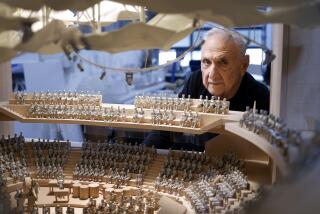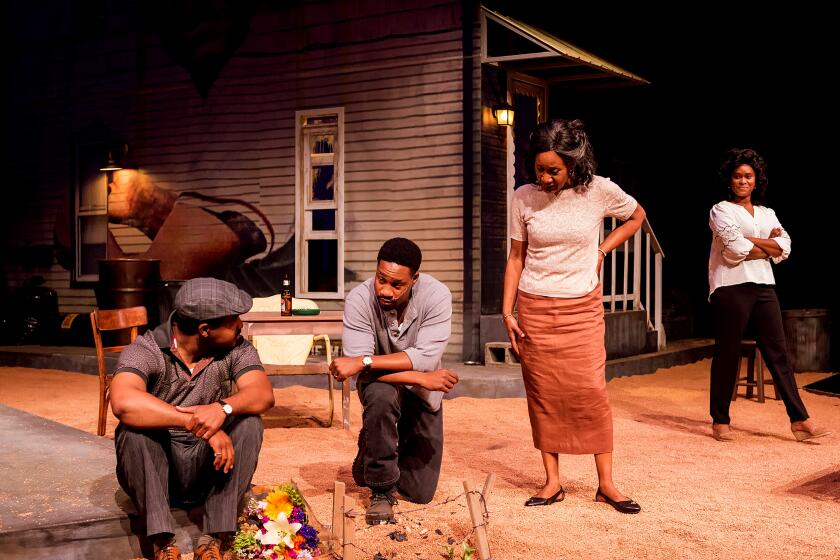An avuncular Frank Gehry takes to the Web in new online master class
“I don’t think you should become … little Frank Gehrys or big Frank Gehrys or even medium Frank Gehrys,” the actual-size Frank Gehry says in the opening session of a course he’s teaching for the online platform Masterclass.
Having enrolled in the course when it was announced earlier this year, I can tell you that the odds of that alchemical transformation, with a viewer suddenly becoming a famous architect of any height, or even just deciding it might be exciting to pursue a career as one, are very slim.
That’s not really the point. “Frank Gehry Teaches Architecture and Design” is instead a wholly accessible and nonthreatening introduction to a major figure in the field. (I’ve watched all five of the sessions so far available, of a promised total of 14.) Imagine you wound up sitting next to the 88-year-old Gehry at a dinner party, found him in an upbeat and talkative mood and screwed up the courage to ask him how he chose architecture as a profession. Or about Sydney Pollack, the late filmmaker and director of a documentary on Gehry’s work. Or why the exterior curves of Walt Disney Concert Hall look the way they do. And that he told you, in some detail, but was then interrupted after about five minutes by the arrival of dessert, at which point the anecdote was stopped cold. The results would be about the same.
Not to spoil the mood, but imagine also that you got a check at the end of that dinner party for $90, which happens to be the cost of the online course.
I haven’t watched any other offerings from Masterclass — they include “Aaron Sorkin Teaches Screenwriting,” “Steve Martin Teaches Comedy,” “Serena Williams Teaches Tennis” and “Deadmau5 Teaches Electronic Music Production” — but the titles alone give you a sense of the pedagogical philosophy at work here. The celebrity quotient is high. So are the production values. The tone is avuncular, aiming for that audience that was once called middlebrow. The sessions range from five to about 15 minutes.
Gehry emerges in the introductory episode onto a set that has been decorated with wooden packing boxes, on top of which are arranged models of some of his best-known projects. These include Disney Hall, the Deutsche Bank headquarters in Berlin and a condo tower on Spruce Street in Lower Manhattan. He sometimes is shown wandering through them — a giant let loose in a little city made entirely of his own buildings, a.k.a. every architect’s dream made real — but more often is seated in another of his designs, the Cross Check armchair.
The only thing missing, as you may have guessed by now, is a student, a stand-in for the audience. A real master class is a strange blend of seminar and performance, a high-stakes event in which a young person appears onstage to be considered, guided and sometimes humiliated by a towering older figure. (Terrence McNally’s 1995 play “Master Class,” which revolves around a session by Maria Callas, gives a good sense of the genre and its protocols.) There is much latent tension — even Oedipal energy — in the generation gap between master and apprentice. What the audience gets to see is not only a lesson about technique but also a parable about beauty and wisdom, youth and old age. The expert holds all the cards in the exchange but also knows that her advantage is temporary and fading.
Gehry, by contrast, has only the camera to address, and as an audience only an anonymous online group watching on screens of various sizes. Given those limitations — and given how many times I’ve heard Gehry describe how as a teenager newly arrived in Los Angeles from Toronto he wound up studying architecture at USC — I was surprised that at least a few nuggets he offered up in the course were new to me.
I never knew (or had forgotten) that one inspiration for the folds in the famous conference room at the heart of the Deutsche Bank design was the work of 14th-century Dutch sculptor Claus Sluter; that construction on the 76-story Spruce Street tower was nearly halted at 40 floors after the 2008 economic crisis hit, which would have left what Gehry calls a “stub” of a skyscraper; or that Gehry considered moving his whole firm to the East Coast in the 1990s, when the fate of long-delayed Disney Hall was looking most dire.
There are also revealing references to the famous Beaux Arts exhibition at the Museum of Modern Art in 1976, a show that helped usher in post-modernist architecture; to Russian painter Kazimir Malevich and what Gehry calls the “dead end” of minimalism; to Japanese artist Hiroshige and his drawings of carp, which helped inspire Gehry’s own fish motif; and to the Walker Art Center’s 1986 retrospective of Gehry’s work. The oversize fish sculptures Gehry designed for that show helped lead, the course suggests, to Gehry’s breakthrough design for the Guggenheim Museum in Bilbao, Spain, a building that will turn 20 this fall.
You have to sort through a fair number of platitudes to get to those gems, though. Gehry is not a theoretician or a philosopher — and has never claimed to be. He has instead hidden his canny approach to architecture and fame behind an aw-shucks persona that has operated as a kind of mask.
The mask thankfully slips from time to time during this master class, revealing an architect who is an authentic intellectual, both curious and worldly. But old habits die hard.
SIGN UP for the free Essential Arts & Culture newsletter »
christopher.hawthorne@latimes.com
Twitter: @HawthorneLAT
More to Read
The biggest entertainment stories
Get our big stories about Hollywood, film, television, music, arts, culture and more right in your inbox as soon as they publish.
You may occasionally receive promotional content from the Los Angeles Times.







